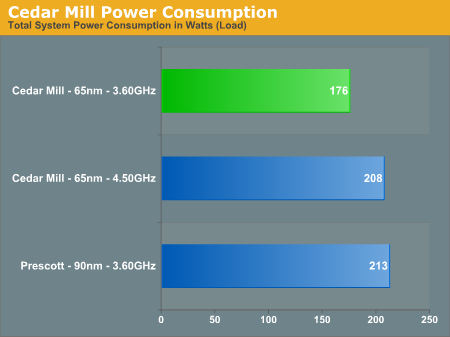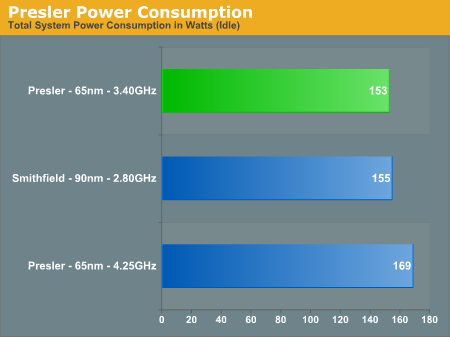Intel's 65nm Processors: Overclocking Preview
by Anand Lal Shimpi on October 25, 2005 12:05 AM EST- Posted in
- CPUs
Power Consumption of Intel's 65nm Processors
Other than poor performance, extremely high power consumption has been a frequently voiced criticism about Intel's Prescott. Thanks to its 31+ stage pipeline and high clock speeds, the Pentium 4 and Pentium D tend to draw quite a bit of power. How does 65nm change the power consumption landscape?
First up is Cedar Mill:
Next up, we loaded two threads of POV-ray's benchmark to fully load the CPUs and compare power consumption under load:
Next, we have Intel's dual core processors - Smithfield (90nm) and Presler (65nm):
Other than poor performance, extremely high power consumption has been a frequently voiced criticism about Intel's Prescott. Thanks to its 31+ stage pipeline and high clock speeds, the Pentium 4 and Pentium D tend to draw quite a bit of power. How does 65nm change the power consumption landscape?
First up is Cedar Mill:

Next up, we loaded two threads of POV-ray's benchmark to fully load the CPUs and compare power consumption under load:

Next, we have Intel's dual core processors - Smithfield (90nm) and Presler (65nm):












43 Comments
View All Comments
semo - Tuesday, October 25, 2005 - link
it is awfully tricky typing with left hand while spinning underpants with right hand and jumping up and down at the same timeyacoub - Tuesday, October 25, 2005 - link
I'm waiting until I can pick up a 5.0GHz dual core Intel chip with an 8MB L2 cache and frickin' flames painted on the sides of it.Griswold - Wednesday, October 26, 2005 - link
With sidepipes too! Pardon me, heat-sidepipes!mlittl3 - Tuesday, October 25, 2005 - link
For all of you asking about AMD's future, here is a link to an article with leaked AMD processor pricing guide (could be fake).http://www.avault.com/news/displaynews.asp?story=1...">http://www.avault.com/news/displaynews.asp?story=1...
Bascially, one can tell from the memo that the FX-60 will probably be dual core 2.8 GHz CPU (increments of 5 instead of two now to match Opteron plus two cores means +5 instead of +2) and there will be a dual core 2.6 GHz called 5000+. All of the single core Athlon 64s will be reduced in price to be below all the dual cores (except the 4000+ will be a little above the x2 3800+). All the semprons will be below single core athlons except the 3400+ sempron will be a bit above the 3000+.
Have fun dreaming of what you are going to buy. From the looks of things, AMD will be phasing out single core high speed processors sooner than we think. That means no 3.0 GHz in '06 Q1. :(
stephenbrooks - Tuesday, October 25, 2005 - link
Uhhh... I think the FX-60 is actually a 3.0GHz DDR2-667 single core part. Looks like the FX-59 3.0GHz DDR-400 got shelved, presumably to avoid confusion having two at the same clock speed but different memory.X2 5000+ ought to be 2.667GHz dual core on DDR2-667.
That is, if you believe this: http://www.c627627.com/AMD/Athlon64/">http://www.c627627.com/AMD/Athlon64/
JarredWalton - Wednesday, October 26, 2005 - link
Not your fault, but I don't believe they have the details correct on that site. In fact, I'm almost sure of it.333 MHz CPU bus speed seems questionable at best to me. We might get that, but right now even the best 939 motherboards get flaky above 300 MHz CPU bus, and DDR2 isn't going to fix that. I'm inclined to think that AMD would go with a 266 bus instead, but really I don't think they'll even do that.
Why? Simple: RAM speed on AMD systems is really independent of CPU bus speed. So, you can have a 200 MHz CPU bus with 1000 MHz HyperTransport, and the RAM can run at anything you want! (The RAM speed is derived from the CPU speed and has nothing to do with the CPU bus speed.) The 1000 MHz HT bus listed leads me to believe AMD will stick with a 200 MHz base CPU bus speed and 5X HT multiplier. The only change will be that instead of a CPU/12 divider on the 2.4 GHz chip, they'd have a CPU/8 divider. (That would actually result in DDR2-600, but since CPU/7 would give DDR2-686, they'll have to stick to the lower speed.)
Given that information, my guess is that the X2 5000+ will actually be the same as the X2 4800+, only with DDR2-667 support on socket M2. In other words, my bet right now is that M2 5000+ will be 2.4 GHz. It makes sense: the socket shift will almost certainly come with a speed increase, and so AMD will have different model numbers for the new sockets. It will basically be like the past: 2.2 GHz 754 is a 3200+ while the 2.2 GHz 939 is a 3500+.
stephenbrooks - Wednesday, October 26, 2005 - link
Yeah the guy changed his roadmap just this afternoon! Sorry about that.A shame really, I'd have liked to see the higher bus, but as you say it's a big jump from the current technology.
mlittl3 - Wednesday, October 26, 2005 - link
I agree with Jared about the FSB. The FSB is not the same on the Athlon 64's as the Athlon XP's and the Pentium 4's, Stephenbrooks. You can't just go to 333 MHz to match the ddr2 memory speeds. The FSB if you can even call it that will always be a HT bus running in half or full duplex mode and will probably stay a multiple of 200 for awhile. Just my guess.But I disagree with Jared about what the chips are in the leaked pricing memo. If it is a true memo, then I think all processors on it are Socket 939 (no DDR2). It says Q1 '06 and I think the new sockets from AMD are not due until March. We are seeing the last of the Socket 939 processors and I think they are trying to move to all dual core similar to intel. Dual core on the FX processor (2.8 GHz giving 5 increment model numbers like the opterons) and a 200 MHz bump on the X2 5000+ to 2.6 GHz. We were all expecting a 2.6 GHz dual core part but a 2.8 GHz is a little iffy without the 65 nm shrink to keep things consuming less power.
Oh well, only time will tell.
JarredWalton - Wednesday, October 26, 2005 - link
Oh, I didn't look at the AV link, mlitt, so I wasn't referring to that information. I'm still wondering what the 5000+ will be. If you look at the clock speeds and past performance, Toledo at 2.6 GHz is almost certainly a 5200+, while Manchester at 2.6 GHz would be the 5000+.2.6 / 2.4 = 1.08333 (8.33% speed increase)
4800 * 1.08333 = 5200
4600 * 1.08333 = 4983
I'd guess we'll see a couple 2.6 GHz socket 939 X2 chips in early 2006. I could be wrong on the socket shift and AMD will just use the same names for the same speed, but the 754 to 939 shift indicates that they like to take advantage of faster platform performance by increasing the model number, so I really don't think they'll do that. If M2 chips are 5% faster than 939 chips, there's no way the marketing department will let that pass by without some hype. :) Besides...
4800 * 1.05 = 5040
4600 * 1.05 = 4830
If the 5% guess is correct, I expect a 200 point model number change. Though it would be nice if they actually didn't overlap numbers, so in the above two instances they could call the 2.4 GHz 512K/1MB M2 chips the 5050+ and 4850+. Wouldn't it be great to actually have less obfuscated performance for once?
mongoosesRawesome - Tuesday, October 25, 2005 - link
I really appreciate this article. Curious as to how you secured these chips without having to sign an NDA.AMD's A64s need to be able to reach 3.0 GHz in order for them to stay competitive with these new 65nm intel chips on the overclocking front. While some of their venice chips are definitely reaching those speeds, especially with a decent voltage bump, most don't quite make it. I expect that by the time these 65nm chips come out though, a 3.0 GHz OC on a 3800+ dual core system should be the norm. Competition is good, now we just need intel to lower their price on their motherboards and not attempt to restrict OCing on their motherboards chipsets.